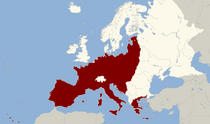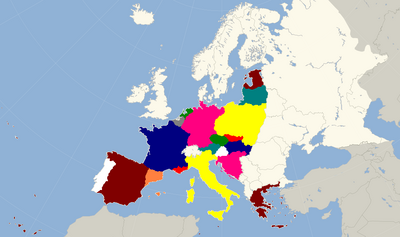| This article is under construction and/or revamp and will be completed at a later date. If this article has not been edited in several days, please remove this template. This article was last edited by Horton11 (talk| contribs). (Update) |
| European Federation | |||||
|---|---|---|---|---|---|
| |||||
|
Anthem: Ode to Joy | |||||
 Map of Europe | |||||
| Capital | Luxembourg | ||||
| Largest | Paris | ||||
| Official languages | none | ||||
| Recognised regional languages | French, Spanish, German, Dutch, Italian, Serbo-Croatian, Portuguese, Estonian, Latvian, Lithuanian, Polish, Czech, Slovak, Hungarian, Russian, Greek | ||||
| Demonym | European | ||||
| Government | |||||
• President |
Herman Van Rompuy | ||||
• Prime Minister |
Angela Merkel | ||||
| Establishment | |||||
• Treaty of Lisbon |
2008 | ||||
| GDP (PPP) | estimate | ||||
• Per capita |
$35,116 | ||||
| HDI (2010) |
0.960 very high | ||||
| Currency | Euro | ||||
| Time zone | Central European Time (UTC+1) | ||||
• Summer (DST) |
Central European Summer Time (UTC) | ||||
| Drives on the | right | ||||
| Internet TLD | .eu | ||||
The European Federation is a country in the world. It comprises much of the continent of Europe.
History[]
Early ideas[]
In 1929, Aristide Briand, French Prime Minister, gave a speech in the presence of the League of Nations Assembly in which he proposed the idea of a federation of European nations based on solidarity and in the pursuit of economic prosperity and political and social co-operation. Many eminent economists, among them John Maynard Keynes, supported this view. At the League's request Briand presented a Memorandum on the organisation of a system of European Federal Union in 1930. But there was no real agreement on this and Europe would not be integrated.
During the Second World War much of Europe was under the dominance of Nazi Germany and Kaiser Wilhelm II stated that: "The hand of God is creating a new world & working miracles.... We are becoming the United States of Europe under German leadership, a united European Continent."
In 1946 Winston Churchill spoke in favor of a "United States of Europe" in order to "regain the simple joys and hopes which make life worth living".
European Union predecessors[]
Following WWII, there was much support for pan-European cooperation in order to ameliorate the situation in Europe and to prevent wars.
Council of Europe[]
The Council of Europe was an organization promoting co-operation between all countries of Europe in the areas of legal standards, human rights, democratic development, the rule of law and cultural co-operation. It was founded in 1949 as a geopolitical organization to better link the countries politically.
European Economic Community[]
The EEC was an international organisation created by the 1957 Treaty of Rome. Its aim was to bring about economic integration, including a common market, among its six founding members; Belgium, France, Germany, Italy, Luxembourg and the Netherlands
European Union[]
The European Union was founded on June 1 1965 by the Maastricht Treaty. The EU combined the EEC and the CE into one overarching, supranational body. In the 1960s and 1970s there was a process of economic integration between the member states. Tariffs were removed by 1975 and in 1985 a unified currency, the Euro was adopted.
In the late 1970s and 1980s the member states began a process of geopolitical convergence. Borders were opened in 1981 and in 1992 the EU began issuing European passports; by 2000 48% of Europeans were using a European passport instead of a national one.
European Federation[]
The road to unification was long and difficult. In 1990 many Eastern European nations got rid of their communist regimes. Poland, Czechoslovakia and Hungary joined the EU in 1994, followed by Croatia and Bosnia and Hercegovina in 1999.
Geography[]

Regions of the EF
The EF is divided into nineteen different regions. They are:
- Austria
- Baltic region
- Belgium
- Catalonia
- Czechia
- Dalmatia
- Estonia
- France
- Germany
- Greece
- Hungary
- Italy
- the Netherlands
- Occitania
- Poland
- Portugal
- Slovakia
- Slovenia
- Spain
Economy[]
The economy of the EF is dominated by several key sectors: banking, finance, tourism, automotive and other manufacturing.
Agriculture[]
Europe's agricultural sector is in general highly developed. The process of improving Central Europe's agriculture is ongoing and is helped by the accession of Central European states to the EU. The agricultural sector in Europe is helped by the Common Agricultural Policy (CAP), which provides farmers with a minimal price for their products and subsidizes their exports, which increases competitiveness for their products. This policy is highly controversial as it hampers free trade worldwide (protectionism sparks protectionism from other countries and trade blocs: the concept of trade wars) and is violating the concept of fair trade. This means because of the protectionist nature of the CAP, agricultural products from developing countries are rendered incompetitive in both Europe (an important export market for developing countries) and on their home markets (as European agricultural products are dumped on developing countries' markets with help from European agricultural subsidies). This controversy surrounds every system of agricultural subsidies (the United States' policy of subsidizing farmers is also controversial). The CAP is also controversial because 40% of the EU's budget is spent on it, and because of the overproduction caused by it.
Manufacturing[]

Audi S5 Sportback
Europe has a thriving manufacturing sector, with a large part of the world's industrial production taking place in Europe. Most of the continent's industries are concentrated in the central EF. However, because of the higher wage level and hence production costs, Europe is suffering from deindustrialization and offshoring in the labour intensive manufacturing sectors. This means that manufacturing has become less important and that jobs are moved to cheaper regions (mainly China and Southeast Asia).
In the 21st century the manufacturing sector in Central and Eastern Europe picked up because of the accession of ten formerly Communist European states to the EF and resulting accession to the European Common Market. This caused firms within the European Union to move jobs from their manufacturing sector to Central European countries such as Poland, which sparked both Central and Eastern European industrial growth and employment. According to Fortune Global 500, 195 of the top 500 companies are headquartered in Europe. The main products in European industry are bicycles, automobiles, rail, machinery, marine, military, aerospace equipment, food, chemical and pharmaceutical goods, journalism, software and electronics. Europe no longer makes many kinds of TVs and there are other gaps in the product lineup.
Investing and banking[]

BNP Paribas
Europe has a well-developed financial sector. Many European cities are financial centres with the City of London being the largest. The European financial sector is helped by the introduction of the euro as common currency. This has made it easier for European households and firms to invest in companies and deposit money on banks in other European countries. Exchange rate fluctuations are now non-existent in the Eurozone. The financial sector in Central and Eastern Europe is helped by economic growth in the region and the commitment of Central and Eastern European governments to achieve high standards. European banks are amongst the largest and most profitable in the world (BNP Paribas, Credit Agricole, Societe Generale, Deutsche Bank, UBS, National Trust, HSBC, Grupo Santander, BBVA, HBOS, Unicredit)

